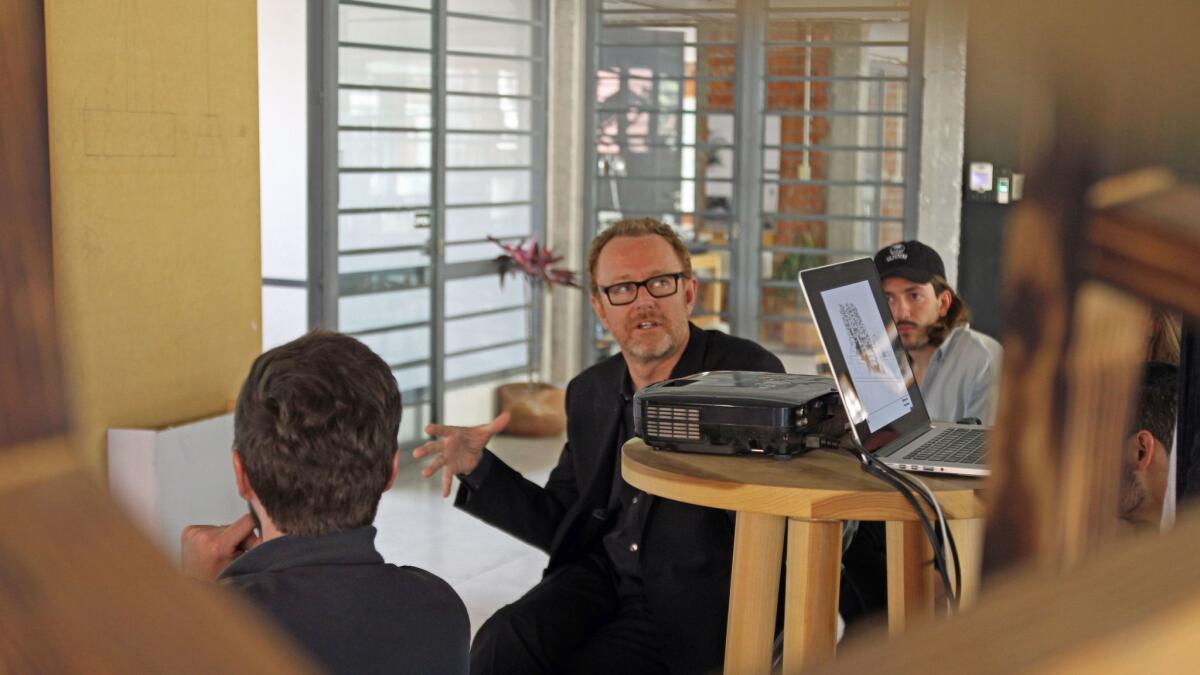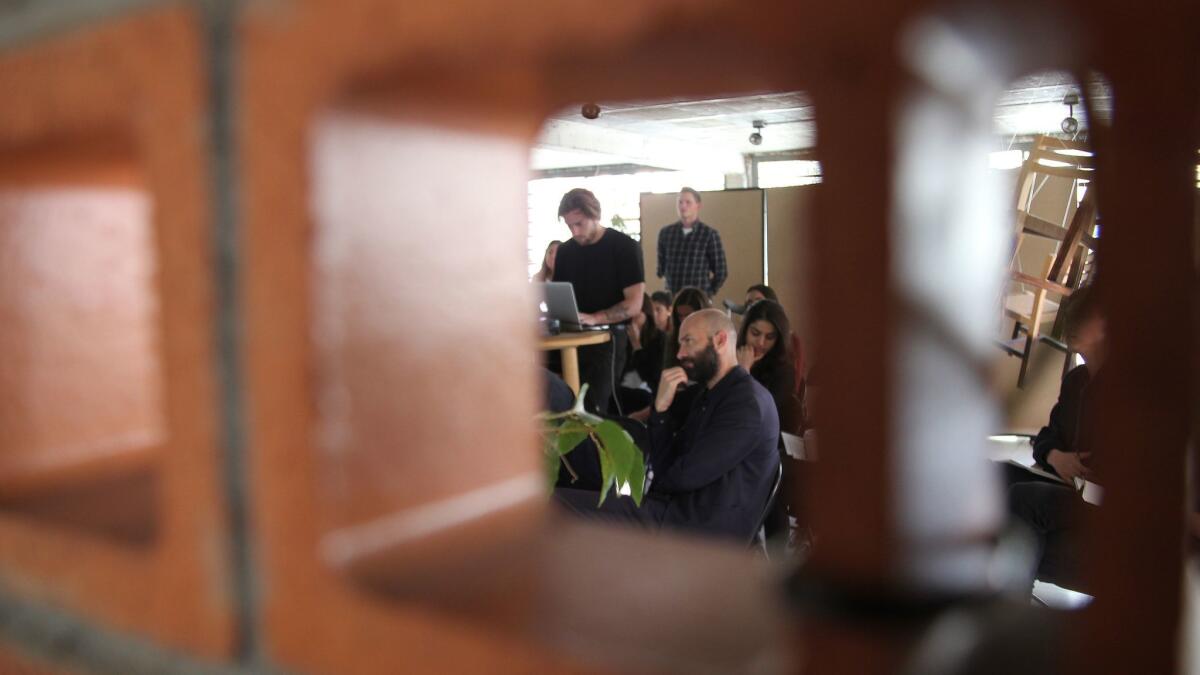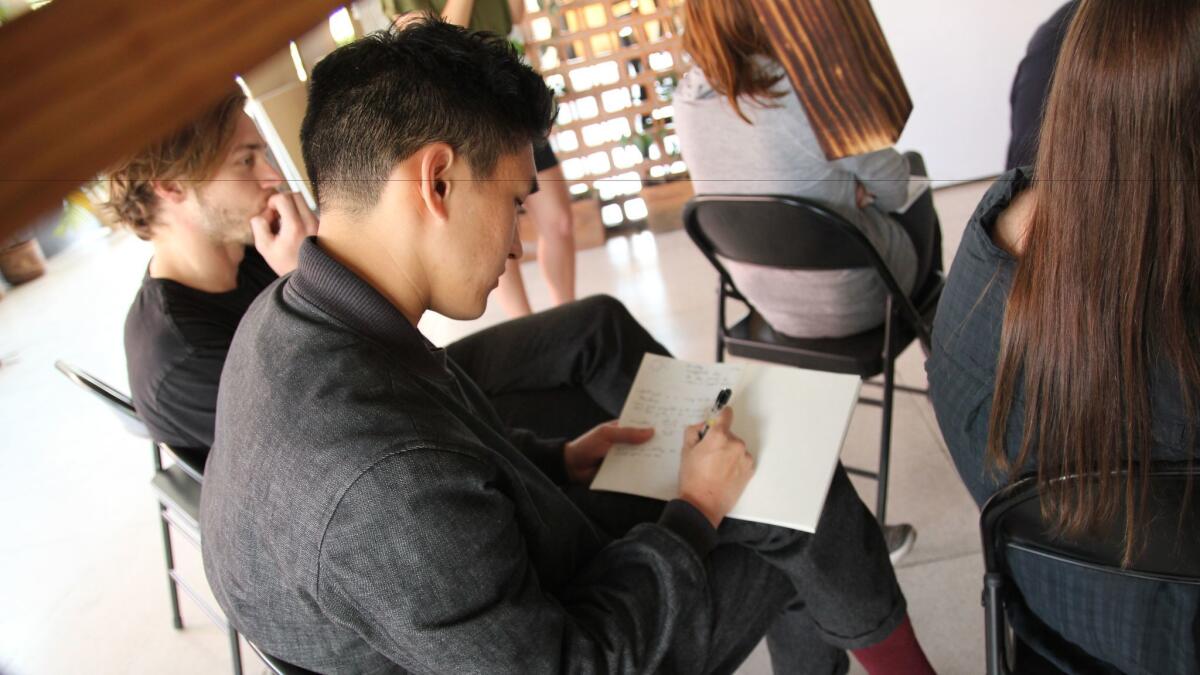As Trump aims to build a wall, Los Angeles architecture school SCI-Arc builds bridges to Mexico

Reporting from Mexico City — A young architecture student pulls up a rendering of a triangular city block on a projector in an unassuming office space at the edge of Mexico City’s Colonia Juárez district.
“The best corner is occupied by a McDonald’s,” he says, gesturing at the schematic on the screen. “I would start by demolishing the McDonald’s.”
The statement is greeted with a laugh by the two dozen architecture students from Mexico and the United States who are part of a bi-national initiative launched last year by the Southern California Institute of Architecture (SCI-Arc) in Los Angeles. They’re in Colonia Juárez on this sunny Friday in early February to present ideas for how the district’s fallow structures and underused lots might be transformed into units of affordable housing.
For students who hail from the U.S. — especially Southern California — the sprawling urban context of Mexico City and its varied neighborhoods offers a familiar model to study.
Like Los Angeles, Mexico City “has a lot of infill,” says architect Francisco Pardo, who is on the faculty at SCI-Arc as well as Mexico’s Universidad Iberoamericana, and coordinates the SCI-Arc Mexico initiative. “It’s a lot of different little cities that form one big city.”
Even so, the cities are at different development stages.
“With 21 million people, [Mexico City] is much larger than Los Angeles,” says architect and SCI-Arc Vice Director John Enright. “But it has similar problems having to do with pollution, traffic, housing. At an urban level, it is the much more dense kind of city that maybe Los Angeles is starting to approach. If Mexico City is a middle aged city and L.A. is an adolescent city, there might be things that we learn.”

To that end, Enright and Pardo have brought together their respective students from SCI-Arc and the Universidad Iberoamericana to study Colonia Juárez block-by-block as a group. As part of the assignment, they are tackling questions of urban renewal and affordable housing — an issue that is as hot a button in Mexico City as it is in Los Angeles.
SCI-Arc Mexico launched well before the U.S. presidential election and Donald Trump’s assumption of power. But the current political climate, filled with news of border walls and travel bans, makes the exchange feel more vital.
For this month’s gathering, U.S. students spent two weeks in Mexico City doing research. In the spring, the Mexican students will travel to SCI-Arc to meet with their U.S. colleagues and have their final projects reviewed by a jury of architects. This intensive time together will allow students from both nations to share knowledge and design approaches.
Travel has always been an integral part of SCI-Arc’s curriculum. But SCI-Arc Mexico represents a more profound commitment to engaging issues of design and urbanism in Latin America.
For SCI-Arc, it’s not just about scheduling the occasional trip. It’s about maintaining a regular presence in the city — including an office where students and faculty can gather and work.
“It’s three-fold,” Enright says of the initiative’s goals. “Our students at SCI-Arc will have a place to visit when they are in Mexico City, a home base. It’s a place to outreach to Mexican architects and potential students who might want to learn about SCI-Arc. And it’s a venue for exhibitions, symposia and other programming for SCI-Arc faculty and scholars.”
In conjunction with this exchange, the school has also developed a fellowship, geared at Mexican nationals, who want to complete their graduate studies at SCI-Arc in the U.S.
The program occupies space in the same office building where the Mexico City-based Pardo, founder of Francisco Pardo Arquitectos, maintains his private studio. (The building, once a corporate headquarters, now functions as a design hub, with private architectural offices and high-end furniture design ateliers.)
It’s an interchange that provides a unique learning opportunity for students from all sides.
“For the Mexican students, it’s a huge learning curve,” Pardo says. “They’re used to more classic training, a more 19th century style, where they present their work, the faculty grades it and then that’s that. But in the U.S. system, they receive critiques from architects, they have to present to a jury, they have to defend their work. That matures them a lot.
“And for the U.S. students, it’s important seeing a city like Mexico City. They can see the social question. SCI-Arc is very experimental, but sometimes the social question gets left out. Here, that is very important. Not every building is a new museum in Los Angeles. There are a lot of other things that go on.”
Administrations come and go, but ideas have longer legs.
— John Enright, SCI-Arc

SCI-Arc Mexico — which is not a full-fledged school, but more of a satellite programming hub — is part of an ongoing series of such spaces being developed by SCI-Arc around the world. Already, the school has a similar initiative in Shanghai. And this fall, Enright expects to open the doors on SCI-Arc Bogotá, in Colombia.
“Architecture is global, and SCI-Arc is global,” Enright says. “We have 56% international students from 40 different countries.”
And Mexico City offers some interesting architectural case studies from which to learn. The city’s urban landscape includes everything from the remnants of pre-Columbian pyramids to the ground-breaking Modernist work of figures such as Luis Barragán.
The history of Colonia Juárez, for instance, is written in its buildings: Beaux Arts structures and Empire-style manses that date back to the district’s settlement in the late 19th century rub shoulders with modern office buildings that arrived after the area was engulfed by greater Mexico City in the 20th century. Once upon a time, Colonia Juárez was prestigious; then it was not — as well-to-do residents fled to tonier developments in the late 20th century and earthquakes took their toll.
“There are layers of architecture — literally,” says Pardo. “Los Angeles is younger, so there aren’t as many layers.”
The students are peeling back those layers to see how they might create a model that could better serve the city’s pressing housing needs — a model that might perhaps one day influence approaches to housing and urban infill in Southern California.
Even as the political relationship between the U.S. and Mexico grows ever chillier, the program at SCI-Arc is solidifying connections between designers and thinkers on either side of the border.
“Our beliefs at SCI-Arc have always been one of openness and of open collegial debate,” Enright says. “Administrations come and go, but ideas have longer legs. That’s our attitude about it.”
Pardo concurs.
“Politics don’t take into account that these connections, they already exist,” he says. “They’ve always existed.”
Sign up for our weekly Essential Arts & Culture newsletter »
ALSO
In Mexico City, a PST LA/LA presentation becomes a cultural salvo in favor of U.S.-Mexico exchange
SCI-Arc’s newly announced director sees growth and a global presence
Where music meets art: Café Tacvba and Santa Cecilia join L.A. Phil to kick off PST LA/LA
More to Read
The biggest entertainment stories
Get our big stories about Hollywood, film, television, music, arts, culture and more right in your inbox as soon as they publish.
You may occasionally receive promotional content from the Los Angeles Times.










